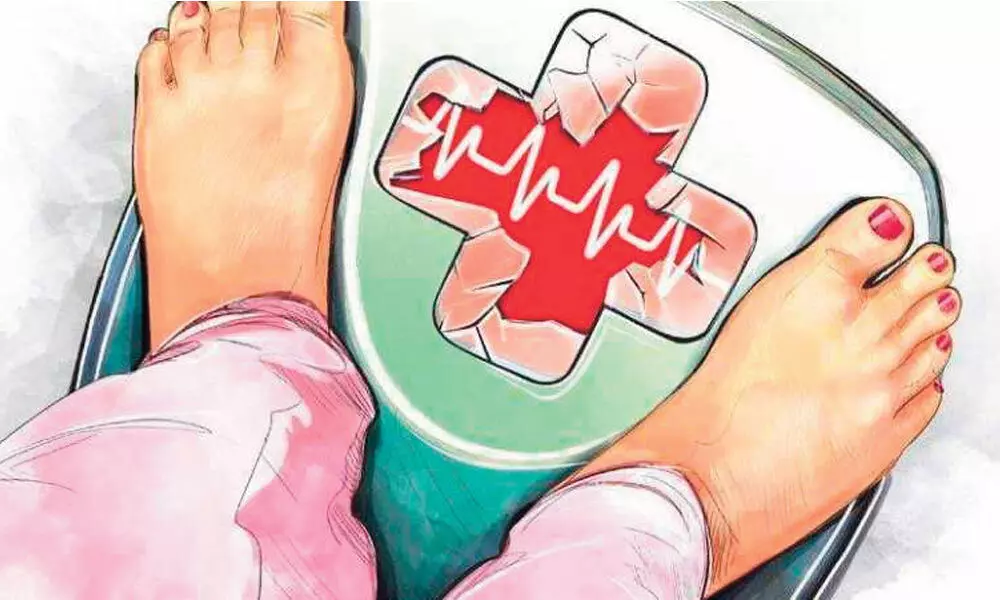7.1 % increase in obese women in five years in Mysuru district, says survey

7.1 % increase in obese women in five years in Mysuru district, says survey
The female population with the age of six years or above who have attended school in the district has increased from 71.3 percent to 72.4 percent, and those who have had 10 and more years of education has increased from 43.3 percent to 49.6 percent. And 78.9 percent women in Mysuru are literate
Mysuru: The fact sheet of Mysuru district in the National Family Health Survey-5 report for Karnataka for 2019-20, released by State health and family welfare department on Tuesday has revealed several startling data related to various significant parameters compared to 2015-16. Compared to 2015-16, the percentage of women between the age of 15 to 49 who are overweight with Body Mask Index higher than 25, has increased to 36.4 percent from 29.3 percent. The percentage of women who are anaemic in the same age group has increased to 48 percent from 45.6 percent in the same period.
It has also revealed that, women whose BMI is below normal (18.5) has come down to 14.7 percent from 19.1 percent. And 54 percent of women had high risk waist-to-hip ratio (above 85) is 54 percent.
As per the report, among those above 15 years of age, 13.8 percent women, 14 percent men had high or very high blood sugar level or were taking medicine to control blood sugar level. And in the same age group, 25.5 percent women and 27.4 percent men suffered hypertension or were taking medicine to control blood pressure.
The report has also revealed that, 24.2 percent pregnant women between the age group of 15 and 49 years were anaemic. The percent of children between 6 and 59 months who are anaemic has decreased to 57.2 percent from 60.1 percent in 2015-16. Compared to 2015-16, the percentage of children who were breastfed within one hour of birth has decreased to 49.9 percent compared to 51.7 percent; the children between six and 23 months who received adequate diet has increased to13.4 percent from 10.4 percent. Among children under 5 years of age, compared to 2015-16, the percentage of children who were shunted (who had lesser height for age) has increased to 27.5 percent from 25.1 percent; the percentage of children whose weight is less than height has decreased to 15.6 percent from 17.3 percent; the percentage of children who are under weight has increased to 28.2 percent from 24.9 percent; the percentage of children who are overweight has decreased to 1.3 percent from 3 percent.
As per the report, compared to 2015-16, the institutional births have increased to 100 percent from 94.7 percent; institutional births at public facility has decreased to 56.2 percent from 69.8 percent; deliveries by caesarean section has increased to 43.7 percent from 33.3 percent; deliveries in caesarean section has increased to 24.7 percent from 24.5 percent in public health facility, and to 67.9 percent from 64.9 percent in private health facility.
The survey has also found that, compared to 2015-16, the female sex ratio per 1000 males has increased from 1008 to 1077 in Mysuru district; the female population with the age of six years or above who have attended school in the district has increased from 71.3 percent to 72.4 percent, and those who have had 10 and more years of education has increased from 43.3 percent to 49.6 percent. And 78.9 percent women in Mysuru are literate.
NFHS-5 has also found that, compared to 2015-16, the percentage of population living in households with electricity has increased from 97.5 percent to 99.5 percent, those with improved drinking water source has reduced from 98.1 percent to 95.4 percent, those with improved sanitation facility has increased from 65 percent to 86.4 percent.














